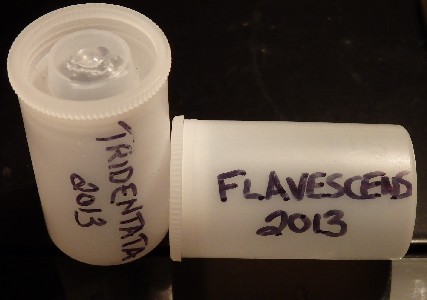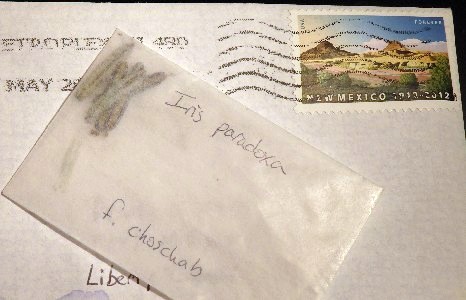 Species Iris Group of North America
Species Iris Group of North America
Publications* ⚜ Species Database ⚜ Spec-X ⚜ IOTM |
|
[What is Spec-X?] ⚜ [Science of Spec-X] ⚜ [Photo Gallery]
Science of Spec-X
One might think that any Iris species could be crossed with any other Iris species, but that is not the case. There are a number of barriers that can prevent such success. I'll attempt to address those in a more-or-less chronological progression.
(3) Physical Barriers - Chihuahuas and Great Danes may be genetically compatible dogs, but they have obvious physical barriers with reproduction. Irises can have similar problems. When pollen touches the stigmatic lip, it "sprouts" or "germinates" and sends a pollen tubule down through the style arm into the flower's ovary where fertilization takes place. Sometimes the pollen tubules of small-flowered species do not reach the ovaries of large-flowered irises. Some people have reported a simple trick to improve our chances. Snap (or cut) the style arm in half (effectively shortening the height/length of the style arm) and apply the pollen on the exposed surface. The tubules should sprout normally, have a chance to reach the ovary, and achieve fertilization.
(5) Chromosome Count - If two species have different chromosome counts, fertilization can fail at the cellular level. This is a complex issue and it is the biggest barrier for making Spec-X hybrids. It is also the reason why Spec-X irises are so exciting! If you ARE successful such crosses with diploid parents are very likely to produce sterile offspring due to the unbalanced chromosomes, effectively making your Spec-X adventure a genetic dead end. Using tetraploid parents will improve your chances for ongoing fertility, but obtaining tetraploid parents is no simple task. (6) Malformed Seeds or Weakened Embryos - Let's say you've overcome all the issues above and you have a cross that produced seeds. Probably your seed pod only contains a few seeds. And some of those seeds may be small or deformed. If you plant them like a regular seed, you might not get any germination. That is why Spec-X hybridizers will employ "enhanced germination techniques". This is a fancy term for a simple activity. It just means cutting, scraping, or otherwise weakening the outer seed shell to give the embryo inside a better chance to germinate. Some hybridizers take additional steps to keep their precious seeds in a sterile, climate-controlled environment to avoid damping off. And some will even surgically remove the embryos and grow them in test tubes on agar. This sounds extreme, but success increases dramatically with these types of techniques. (7) Careful Culture - Your new seedlings may be blessed with hybrid vigor and grow & thrive in your garden. Or they may inherit strange tendencies from the parents. Crossing a dry-loving iris with a moisture-loving iris can make for some difficult decisions about raising the seedlings. The best advice here is "don't put all your eggs in one basket". If you have a dozen babies, try growing them in different places around your garden. Don't risk losing everything due to one mistake! If you're able to do so, divide & share your seedlings with friends even before they bloom. Having a crop failure due to drought or hard freeze is not so painful if someone elsewhere is growing your babies. A few more words of wisdom...
|
|
© 2024, SIGNA.
For general inquiries about SIGNA please contact Rodney Barton.
Please report technical problems to dkramb@gmail.com.
|
 (1) Asynchronous Flowering - If bloom times aren't synchronized, how can two species be crossed? For solving this problem we are lucky, because Iris pollen is easy to store in a refrigerator freezer. Many people use old 35mm film canisters, and others use empty prescription drug bottles. The key is to keep the pollen in a air-tight container. Pollen is harvested by plucking the anthers from a blooming flower with tweezers, then dropping the anther into the container. Label the container with the species name & date of collection. Frozen pollen can remain viable for a year or more. When you're ready to apply it, allow it to thaw BEFORE opening the container.
(1) Asynchronous Flowering - If bloom times aren't synchronized, how can two species be crossed? For solving this problem we are lucky, because Iris pollen is easy to store in a refrigerator freezer. Many people use old 35mm film canisters, and others use empty prescription drug bottles. The key is to keep the pollen in a air-tight container. Pollen is harvested by plucking the anthers from a blooming flower with tweezers, then dropping the anther into the container. Label the container with the species name & date of collection. Frozen pollen can remain viable for a year or more. When you're ready to apply it, allow it to thaw BEFORE opening the container. (2) Geography & Climate - If two species don't (or can't) grow in the same region, how can they be crossed?
(2) Geography & Climate - If two species don't (or can't) grow in the same region, how can they be crossed? (4) Contamination - Bees love pollinating irises. Sometimes it's hard to beat them to a fresh flower and it's impossible to control what pollen they're carrying. They can seriously mess up your results if proper steps aren't taken. Otherwise you may grow your seedlings for 2 or 3 years only to find out they're not YOUR hybrids, but some bee's instead. One trick is to cover the buds with a fine mesh fabric (such as a lady's stocking) that blocks pollinators from reaching the flower. Earwigs can be a nuisance with this set-up, though, especially if the fabric is left on for the duration of the pod development. Another option is to gently force open the flower bud and physically remove the falls. The falls are the bee's landing pad, so removing them protects your flower from unwanted pollen.
(4) Contamination - Bees love pollinating irises. Sometimes it's hard to beat them to a fresh flower and it's impossible to control what pollen they're carrying. They can seriously mess up your results if proper steps aren't taken. Otherwise you may grow your seedlings for 2 or 3 years only to find out they're not YOUR hybrids, but some bee's instead. One trick is to cover the buds with a fine mesh fabric (such as a lady's stocking) that blocks pollinators from reaching the flower. Earwigs can be a nuisance with this set-up, though, especially if the fabric is left on for the duration of the pod development. Another option is to gently force open the flower bud and physically remove the falls. The falls are the bee's landing pad, so removing them protects your flower from unwanted pollen.